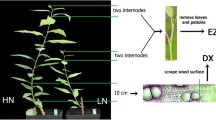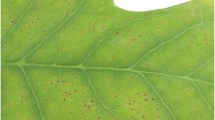Abstract
The shikimate pathway plays a pivotal role in the formation of aromatic secondary compounds in plants. It finally leads to the formation of, for example, stilbenes, flavonoids, and lignins. Ozone effects on transcript levels of the shikimate pathway were studied in leaves of European beech saplings in the greenhouse (300 nl l−1, 8 h/day, 30 days), and in leaves of adult beech trees at the Kranzberg Forest free-air ozone fumigation site (ambient and twice ambient ozone levels) between June and October 2004. Quantitative real-time RT-PCR (qRT-PCR) with RNA isolated from beech saplings showed a strong induction of 3-deoxy-d-arabino-heptulosonate-7-phosphate synthase3 (DAHPS3), 3-dehydroquinate dehydratase/shikimate dehydrogenase (DHQD/SD), 5-enolpyruvylshikimate 3-phosphate synthase (EPSPS), and chorismate mutase (CM) starting at day seven from the onset of ozone treatment. In contrast, sun leaves of adult European beech showed only a weak elevation of shikimate pathway transcripts throughout the vegetation period studied. In addition, we examined lignin content and monomeric structure in leaves of European beech saplings from the greenhouse experiment. Leaves exhibiting highest amount of ozone-dependent lesions had the highest lignin content as determined according to Klason. Moreover, with increasing leaf damage, the syringyl (S) monomer content decreased, whereas the content of guaiacyl (G) and p-hydroxyphenyl (H) units increased. These results overall suggest that the composition of lignin is affected by ozone and is already regulated at early steps of the shikimate pathway.


Similar content being viewed by others
References
Bahnweg G, Heller W, Stich S, Knappe K, Betz G, Heerdt C, Kehr RD, Ernst D, Langebartels C, Nunn AJ, Rothenburger J, Schubert R, Wallis P, Müller-Starck G, Werner H, Matyssek R, Sandermann H (2005) Beech leaf colonization by the endophyte Apiognomonia errabunda dramatically depends on light exposure and climatic conditions. Plant Biol 7:659–669
Baillères H, Castan M, Monties B, Pollet B, Lapierre C (1997) Lignin structure in Buxus sempervirens reaction wood. Phytochemistry 44:35–39
Batz O, Logemann E, Reinold S, Hahlbrock K (1998) Extensive reprogramming of primary and secondary metabolism by fungal elicitor or infection in parsley cells. Biol Chem 379:1127–1135
Baucher M, Monties B, Van Montagu M, Boerjan W (1998) Biosynthesis and genetic engineering of lignin. Crit Rev Plant Sci 17:125–197
Baumgarten M, Werner H, Häberle K–H, Emberson LD, Fabian P, Matyssek R (2000) Seasonal ozone response of mature beech trees at high altitude in the Bavarian forest (Germany) in comparison with young beech grown in the field and in phytotrons. Environ Pollut 109:431–442
Bentley R, Haslam E (1990) The shikimate pathway—a metabolic tree with many branches. Crit Rev Biochem Mol Biol 25:307–384
Bischoff M, Rösler J, Raesecke HR, Görlach J, Amrhein N, Schmid J (1996) Cloning of a cDNA encoding a 3-dehydroquinate synthase from a higher plant, and analysis of the organ-specific and elicitor-induced expression of the corresponding gene. Plant Mol Biol 31:69–76
Bischoff M, Schaller A, Bieri F, Kessler F, Amrhein N, Schmid J (2001) Molecular characterization of tomato 3-dehydroquinate dehydratase-shikimate:NADPH oxidoreductase. Plant Physiol 125:1891–1900
Boerjan W, Ralph J, Baucher M (2003) Lignin biosynthesis. Annu Rev Plant Biol Plant Physiol 54:519–546
Boerner REJ, Rebbeck J (1995) Decomposition and nitrogen release from leaves of three hard wood species grown under elevated O3 and/or CO2. Plant Soil 54:149–157
Bonello P, Heller W, Sandermann H (1993) Ozone effects on root-disease susceptibility and defence responses in mycorrhizal and non-mycorrhizal Scots pine (Pinus sylvestris L.). New Phytol 123:653–663
Booker FL, Anttonen S, Heagle AS (1996) Catechin, proanthocyanidin and lignin contents of loblolly pine (Pinus taeda) needles after chronic exposure to ozone. New Phytol 132:483–492
Boudet AM, Hawkins S, Cabané M, Ernst D, Galliano H, Heller W, Lange M, Sandermann H, Lapierre C (1995a) Development and stress lignification. In: Sandermann H, Bonnet-Masimbert M (eds) EUROSILVA: contribution to Forest Tree Physiology. INRA, Paris, pp 13–34
Boudet AM, Lapierre C, Grima-Pettenati J (1995b) Biochemistry and molecular biology of lignification. New Phytol 129:203–236
Broadmeadow M (1998) Ozone and forest trees. New Phytol 139:123–125
Cabané M, Pireaux J-C, Leger E, Weber E, Dizengremel P, Pollet B, Lapierre C (2004) Condensed lignins are synthesized in poplar leaves exposed to ozone. Plant Physiol 134:586–594
Dence CW (1992) The determination of lignin. In: Lin SY, Dence CW (eds) Methods in lignin chemistry. Springer, Heidelberg, pp 33–61
Dyer WE, Henstrand JM, Handa AK, Herrmann KM (1989) Wounding induces the first enzyme of the shikimate pathway in Solanaceae. Proc Natl Acad Sci USA 86:7370–7373
Eckey-Kaltenbach H, Ernst D, Heller W, Sandermann H (1994) Biochemical plant responses to ozone: IV. Cross-induction of defensive pathways in parsley (Petroselinum crispum L.) plants. Plant Physiol 104:67–74
Galliano H, Heller W, Sandermann H (1993a) Ozone induction and purification of spruce cinnamyl alcohol dehydrogenase. Phytochemistry 32:557–563
Galliano H, Cabané M, Eckerskorn C, Lottspeich F, Sandermann H, Ernst D (1993b) Molecular cloning, sequence analysis and elicitor-/ozone-induced accumulation of cinnamyl alcohol dehydrogenase from Norway spruce (Picea abies L.). Plant Mol Biol 23:145–156
Görlach J, Raesecke HR, Rentsch D, Regenass M, Roy P, Zala M, Keel C, Boller T, Amrhein N, Schmid J (1995) Temporally distinct accumulation of transcripts encoding enzymes of the prechorismate pathway in elicitor treated, cultured tomato cells. Proc Natl Acad Sci USA 92:3166–3170
Gupta P, Duplessis S, White H, Karnosky DF, Martin F, Podila GK (2005) Gene expression patterns of trembling aspen trees following long-term exposure to interacting elevated CO2 and tropospheric O3. New Phytol 167:129–142
Henstrand JM, McCue KF, Brink K, Handa AK, Herrmann KM, Conn EE (1992) Light and fungal elicitor induce 3-deoxy-D-arabino-heptulosonate 7-phosphate synthase mRNA in suspension cultured cells of parsley (Petroselinum crispum L.). Plant Physiol 98:761–763
Herrmann KM, Weaver LM (1999) The shikimate pathway. Annu Rev Plant Physiol Plant Mol Biol 50:473–503
Janzik I, Preiskowski S, Kneifel H (2005) Ozone has dramatic effects on the regulation of the prechorismate pathway in tobacco (Nicotiana tabacum L. cv. Bel W3). Planta 223:20–27
Jehnes S, Betz G, Bahnweg G, Haberer K, Sandermann H, Rennenberg H (2007) Injury amplification reactions and tree internal signalling under ozone exposure in European beech (Fagus sylvatica) trees. Plant Biol 9:253–264
Joseleau J-P, Imai T, Kuroda K, Ruel K (2004) Detection in situ and characterization of lignin in the G-layer of tension wood fibres of Populus deltoides. Planta 219:338–345
Kangasjärvi J, Talvinen J, Utriainen M, Karjalainen R (1994) Plant defence systems induced by ozone. Plant Cell Environ 17:783–794
Keith B, Dong X, Ausubel F, Fink GR (1991) Differential induction of 3-deoxy-D-arabino-heptulosonate 7-phosphate synthase genes in Arabidopsis thaliana by wounding and pathogenic attack. Proc Natl Acad Sci USA 88:8821–8825
Kiefer E, Heller W, Ernst D (2000) A simple and efficient protocol for isolation of functional RNA from plant tissues rich in secondary metabolites. Plant Mol Biol Rep 18:33–39
Koch JR, Scherzer AJ, Eshita SM, Davis KR (1998) Ozone sensitivity in hybrid poplar is correlated with a lack of defense-gene activation. Plant Physiol 118:1243–1252
Lange BM, Lapierre C, Sandermann H (1995) Elicitor-induced spruce stress lignin: structural similarity to early developmental lignins. Plant Physiol 108:1277–1287
Langebartels C, Schraudner M, Heller W, Ernst D, Sandermann H (2002) Oxidative stress and defense reactions in plants exposed to air pollutants and UV-B radiation. In: Inzé D, Van Montagu M (eds) Oxidative stress in plants, Taylor & Francis, London, pp 105–135
Lapierre C, Pollet B, Petit-Conil M, Toval G, Romero J, Pilate G, Leplé J-C, Boerjan W, Ferret V, De Nadai V, Jouanin L (1999) Structural alterations of lignins in transgenic poplars with depressed cinnamyl alcohol dehydrogenase or caffeic acid O-methyltransferase activity have an opposite impact on the efficiency of industrial Kraft pulping. Plant Physiol 119:153–164
Li P, Mane SP, Sioson AA, Robinet CV, Heath LS, Bohnert HJ, Grene R (2006) Effects of chronic ozone exposure on gene expression in Arabidopsis thaliana ecotypes and in Thellungiella halophila. Plant Cell Environ 29:854–868
Maier-Maercker U (1999) Predisposition of trees to drought stress by ozone. Tree Physiol 19:71–78
Matyssek R, Schnyder H, Elstner E-F, Munch J-C, Pretzsch H, Sandermann H (2002) Growth and parasite defence in plants; the balance between resource sequestration and retention: in lieu of a guest editorial. Plant Biol 4:133–136
Matyssek R, Wieser G, Nunn AJ, Kozovits AR, Reiter IM, Heerdt C, Winkler JB, Baumgarten M, Häberle K-H, Grams TEE, Werner H, Fabian P, Havranek WM (2004) Comparison between AOT40 and ozone uptake in forest trees of different species, age and site conditions. Atmos Environ 38:2271–2281
Matyssek R, Agerer R, Ernst D, Munch J-C, Oßwald W, Pretzsch H, Priesack E, Schnyder H, Treutter D (2005) The plant’s capacity in regulating resource demand. Plant Biol 7:560–580
McCue KF, Conn EE (1989) Induction of 3-deoxy-D-arabino-heptulosonate 7-phosphate synthase activity by fungal elicitor in cultures of Petroselinum crispum. Proc Natl Acad Sci USA 86:7374–7377
Miyazaki S, Fredricksen M, Hollis KC, Poroyko V, Shepley D, Galbraith DW, Long SP, Bohnert HJ (2004) Transcript expression profiles of Arabidopsis thaliana grown under controlled conditions and open-air elevated concentrations of CO2 and of O3. Field Crops Res 90:47–59
Muday GK, Herrmann KM (1992) Wounding induces one of two isoenzymes of 3-deoxy-D-arabino-heptulosonate 7-phosphate synthase in Solanum tuberosum. Plant Physiol 98:496–500
Oksanen E, Riikonen J, Kaakinen S, Holopainen T, Vapaavuor E (2005) Structural characteristics and chemical composition of birch (Betula pendula) leaves are modified by increasing CO2 and ozone. Global Change Biol 11:732–748
Olbrich M, Betz G, Gerstner E, Langebartels C, Sandermann H, Ernst D (2005) Transcriptome analysis of ozone-responsive genes in leaves of European beech (Fagus sylvatica L.). Plant Biol 7:670–676
Pretzsch H, Kahn M, Grote R (1998) The mixed spruce-beech forest stands of the “Sonderforschungsbereich” “Growth or Parasite Defence?” in the forest district Kranzberger Forst. Forstw Cbl 117:241–257
Sandermann H (1996) Ozone and plant health. Annu Rev Phytopathol 34:347–366
Sandermann H, Ernst D, Heller W, Langebartels C (1998) Ozone: an abiotic elicitor of plant defence reactions. Trends Plant Sci 3:47–50
Sharma YK, Davis KR (1994) Ozone-induced expression of stress-related genes in Arabidopsis thaliana. Plant Physiol 105:1089–1096
Tuomainen J, Pellinen R, Roy S, Kiiskinen M, Eloranta T, Karjalainen R, Kangasjärvi J (1996) Ozone affects birch (Betula pendula Roth) phenylpropanoid, polyamine and active oxygen detoxifying pathways at biochemical and gene expression level. J Plant Physiol 148:179–188
Vollenweider P, Ottiger M, Günthardt-Goerg MS (2003) Validation of ozone symptoms in natural vegeation using microscopical methods. Environ Pollut 124:101–118
Walter MH (1992) Regulation of lignification in defense. In: Boller T, Moing F (eds) Advances in plant gene research, vol 8. Genes involved in plant defense. Springer, Wien, pp 327–352
Werner H, Fabian P (2002) Free-air fumigation on mature trees: a novel system for controlled ozone enrichment in grown-up beech and spruce canopies. Environ Sci Pollut Res 9:117–121
Acknowledgments
We are grateful to the staff of the Kranzberg Forest station for their excellent scientific and technical assistance. We wish to thank the staff of the Helmholtz Zentrum München Department of Environmental Engineering for their excellent technical support during the greenhouse experiments. We also sincerely acknowledge the technical assistance of Laurent Cézard (INRA) and of Frédéric Legée (AgroParisTech) for the thioacidolysis and Klason determinations. This research was part of a project funded by the Deutsche Forschungsgemeinschaft under the contract number SFB 607.
Author information
Authors and Affiliations
Corresponding author
Additional information
Communicated by A. Roloff.
This article belongs to the special issue “Growth and defense of Norway spruce and European beech in pure and mixed stands”.
Rights and permissions
About this article
Cite this article
Betz, G.A., Knappe, C., Lapierre, C. et al. Ozone affects shikimate pathway transcripts and monomeric lignin composition in European beech (Fagus sylvatica L.). Eur J Forest Res 128, 109–116 (2009). https://doi.org/10.1007/s10342-008-0216-8
Received:
Revised:
Accepted:
Published:
Issue Date:
DOI: https://doi.org/10.1007/s10342-008-0216-8




